Dealing with tiny bugs buzzing around your kitchen? You might have fruit flies! These common pests are more of a nuisance than a major problem, and the good news is getting rid of them doesn’t require expensive solutions or harsh chemicals. You likely have everything you need right in your home!
Recently, we experienced a fruit fly invasion in our own kitchen – a first in over four years! This unexpected situation became the perfect opportunity to test and document seven different fruit fly elimination methods. Yes, spreadsheets and detailed notes were involved! Today, I’m excited to share the most effective homemade fruit fly traps and guide you on how to make them.
Each DIY trap is simple to assemble using natural, household ingredients, making them incredibly easy and chemical-free. If you prefer a humane approach, these traps also allow you to release the fruit flies outdoors. We’ll explore humane options and also provide essential tips to prevent future fruit fly infestations.
Understanding Fruit Flies
Fruit flies are small, winged insects that are strongly attracted to sweet and fermenting substances, particularly fruits and vegetables (hence their name). They are also drawn to sugary drinks like beer, wine, and juice. You’ll often find them congregating around fruit bowls, garbage disposals, compost bins, and even sink drains. They are about the size of a grain of rice, resembling small, tan or brownish houseflies with distinctive red eyes. Fruit flies are most prevalent during the warmer months of summer and late fall, coinciding with fruit harvesting seasons.
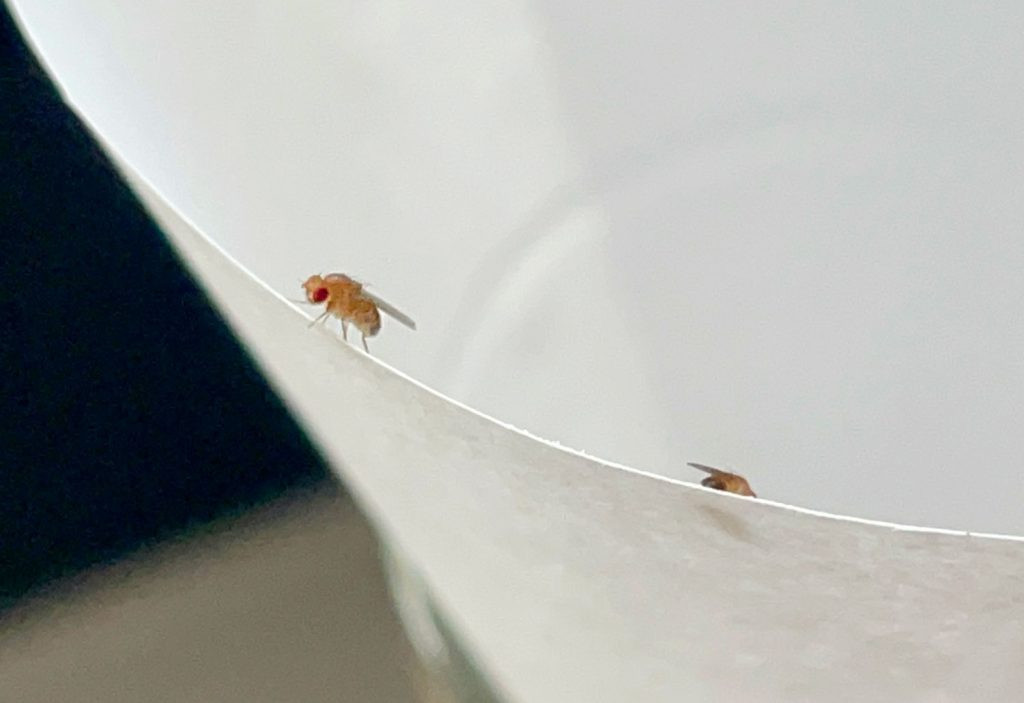 Close Up Of Fruit Fly On Paper Funnel
Close Up Of Fruit Fly On Paper Funnel
A fruit fly infestation often begins when a few individuals are unknowingly brought into your home on fresh produce. However, female fruit flies can lay hundreds of eggs in their short lifespan, and these eggs can hatch in as little as 12 hours. They rapidly mature to adulthood in just a few days, meaning a small initial presence can quickly escalate into a large swarm. This rapid reproduction cycle is why prompt action is crucial to eliminate fruit flies as soon as you notice them.
Fruit Flies vs. Fungus Gnats vs. Drain Flies: Identification is Key
Fruit flies are often mistaken for other small flying insects commonly found indoors, particularly fungus gnats and drain flies. While all are tiny and winged, accurate identification is important to ensure you use the most effective removal methods. The easiest way to differentiate them is by observing where you typically see them and what larger insect they most closely resemble:
- Fruit Flies: Resemble small flies and are usually seen near fruit bowls, open trash cans, or any sources of fermenting or decaying food.
- Drain Flies: Look like small, fuzzy moths. As their name suggests, they are commonly found near sinks, drains, and areas with moisture.
- Fungus Gnats: Appear similar to small mosquitos. They are usually found around houseplants, as they breed in damp potting soil.
If you are uncertain which pest you’re dealing with, trying one of the traps described below can help. If the trap attracts the insects, you’ll know you’re dealing with fruit flies!
4 Simple DIY Fruit Fly Traps
Getting rid of fruit flies doesn’t have to be a complicated or expensive process. You likely have all the necessary supplies already in your kitchen. Each of these traps operates on a simple principle: attract the fruit flies to a tempting lure and then prevent them from escaping. We tested the following 4 DIY methods and found a clear winner. Since each method uses common household items, feel free to experiment with more than one to see what works best for you. Becoming a fruit fly scientist can actually be quite interesting! Here are the first 4 methods we tested:
- Funnel Trap
- Plastic Wrap Trap
- Dish Soap Trap
- Rotting Fruit Trap
Let’s delve into the details of each method, and I’ll share our findings on their effectiveness. Keep in mind that some traps work faster than others, and it may take a few days to completely eliminate your fruit fly problem.
#1: The Paper Funnel Fruit Fly Trap
This trap design uses a paper funnel to guide fruit flies into a container. The narrow opening at the bottom of the funnel makes it easy for them to enter but difficult to exit.
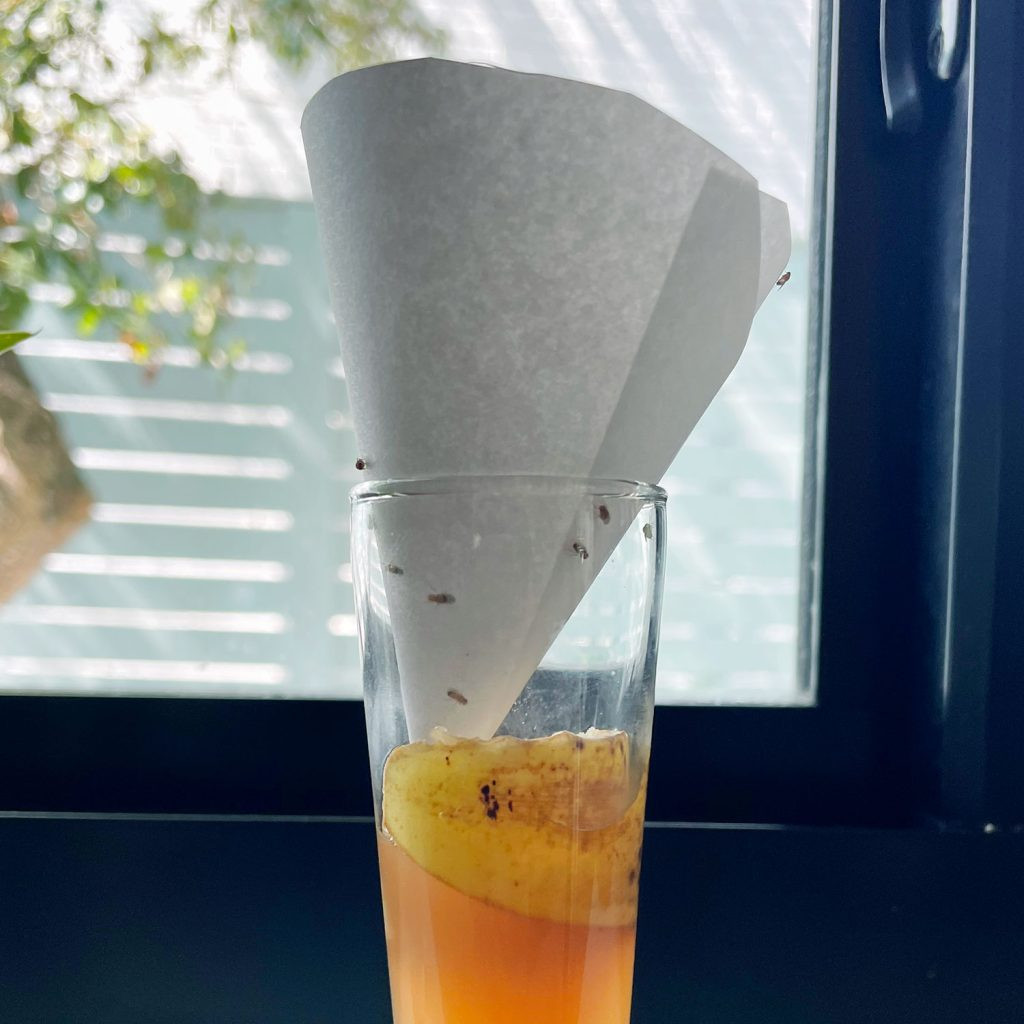 DIY Fruit Fly Trap With Paper Funnel
DIY Fruit Fly Trap With Paper Funnel
Supplies you’ll need:
- Small, clear jar, cup, or container – a narrow opening is preferable.
- A sheet of paper or cardstock.
- Tape.
- Scissors.
- Apple cider vinegar (ACV).
Instructions:
- Choose your container: Select a small, clear container. An old food jar or a plastic soda bottle works well. For this method, containers with smaller openings are more effective.
- Add the attractant: Pour a small amount of apple cider vinegar, old beer, or wine into the bottom of the container. These liquids are excellent fruit fly lures.
- Create the paper funnel: Shape a piece of paper or cardstock into a cone with a very small opening at the pointed end. Secure the cone shape with tape. You can cut the small opening at the tip after forming the cone if that’s easier. The opening only needs to be about the size of a grain of rice.
- Assemble the trap: Place the paper funnel into the opening of your container. You may need to adjust the funnel’s width so it rests securely on the container’s opening without touching the liquid bait. Ensure the funnel fits snugly against all edges of the opening to prevent fly escapes.
- (Optional) Humane Release: To release trapped flies, carefully take the entire trap outdoors, being careful not to dislodge the funnel (or the flies will escape). Once outside, remove the funnel and allow the fruit flies to fly away.
While you can use a store-bought funnel, the opening at the bottom might be too wide, allowing more fruit flies to escape the trap.
#2: The Plastic Wrap Fruit Fly Trap
Similar to the funnel trap, this method uses apple cider vinegar to attract fruit flies. They enter the trap through tiny holes poked in plastic wrap stretched tightly over the container opening, but then struggle to find their way back out.
Supplies you’ll need:
- Small, clear jar, cup, or container.
- Rubber band.
- Plastic wrap or a plastic bag.
- Toothpick.
- Apple cider vinegar (ACV).
Instructions:
- Select your container: Choose a small, clear jar, cup, or glass container. Almost any size will work. Clear containers make it easier to monitor your trapping progress, but even an old soda or beer can will do.
- Add the lure: Pour apple cider vinegar into the container. The enticing scent will draw in the fruit flies. Old beer or wine are also effective alternatives, but regular white vinegar is not as attractive to them.
- Cover the opening: Stretch plastic wrap tightly over the opening of your container and secure it firmly with a rubber band. Saran wrap is ideal, but you can also use a piece cut from a plastic bag.
- Create entrance holes: Use a toothpick to carefully poke a few small holes in the plastic wrap. You don’t need many holes, just ensure they are large enough for a fruit fly to enter.
- (Optional) Humane Release: To release the trapped fruit flies, carefully carry the entire trap outside without removing the plastic wrap cover. Once outdoors, remove the plastic wrap and let them fly away.
Alternatively, you can create a similar trap using a metal jar lid. Use a mason jar or an old food jar with a metal lid. Carefully puncture a small hole in the lid using a hammer and nail.
#3: The Dish Soap Fruit Fly Trap
This trap differs from the previous two by not requiring a cover. Instead, it uses a soapy surface tension to trap fruit flies. Note: This method is not humane as the soap will prevent the flies from escaping and will ultimately lead to their demise.
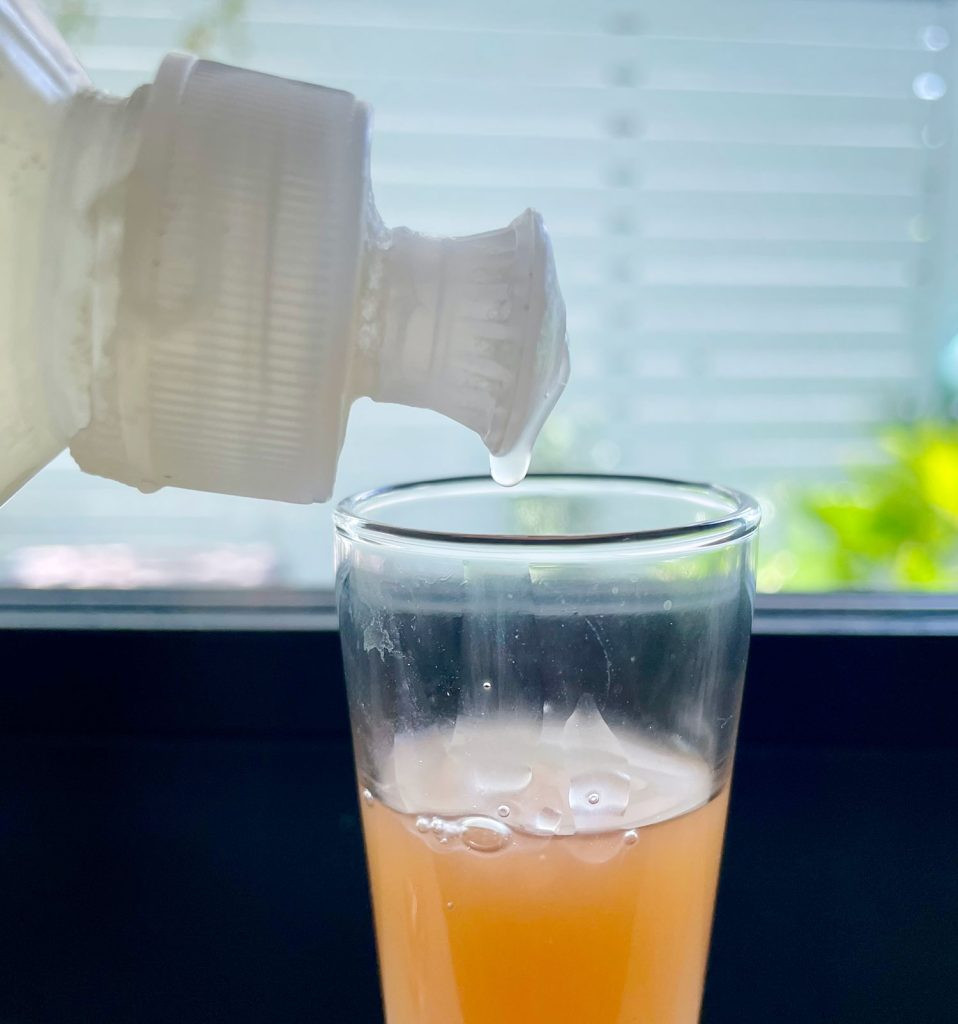 Dripping Dish Soap Into Apple Cider Vinegar For DIY Fruit Fly Trap
Dripping Dish Soap Into Apple Cider Vinegar For DIY Fruit Fly Trap
Supplies you’ll need:
- Small container, bowl, or dish.
- Dish soap.
- Apple cider vinegar (ACV).
Instructions:
- Pour apple cider vinegar: Fill the bottom of your chosen container, bowl, or dish with apple cider vinegar. This will serve as the primary attractant.
- Add dish soap: Squirt several drops of dish soap into the apple cider vinegar. Gently mix to create a thin layer of soapy solution on the surface. The soap breaks the surface tension of the vinegar, so when fruit flies land on the mixture, they will sink and become trapped instead of being able to fly away.
You can also enhance the plastic wrap and funnel traps by adding dish soap to the apple cider vinegar before covering the top. This adds another trapping mechanism to your setup.
#4: The Rotting Fruit Fruit Fly Trap
This variation replaces apple cider vinegar with the fruit flies’ ultimate temptation: actual rotting fruit!
Supplies you’ll need:
- Small glass jar, cup, or container.
- Plastic wrap or paper funnel, depending on your chosen trap design.
- A small piece of overripe fruit, such as a banana peel or apple slice.
Instructions:
To create a rotting fruit trap, simply substitute the apple cider vinegar in either the Plastic Wrap Trap or Funnel Trap with a piece of banana peel, apple slice, or peach. You can also add a fruit scrap to your apple cider vinegar for a boosted attractant. Be aware that you’ll need to replace the fruit scrap every day or two to prevent unpleasant odors in your kitchen.
Determining the Best Fruit Fly Trap
As shown in these photos, we tested four different DIY trap combinations to evaluate their performance. The homemade traps we compared were:
- Plastic Wrap Trap with banana peel.
- Funnel Trap with ACV + banana peel.
- Plastic Wrap Trap with ACV + dish soap.
- Dish Soap Trap with ACV only.
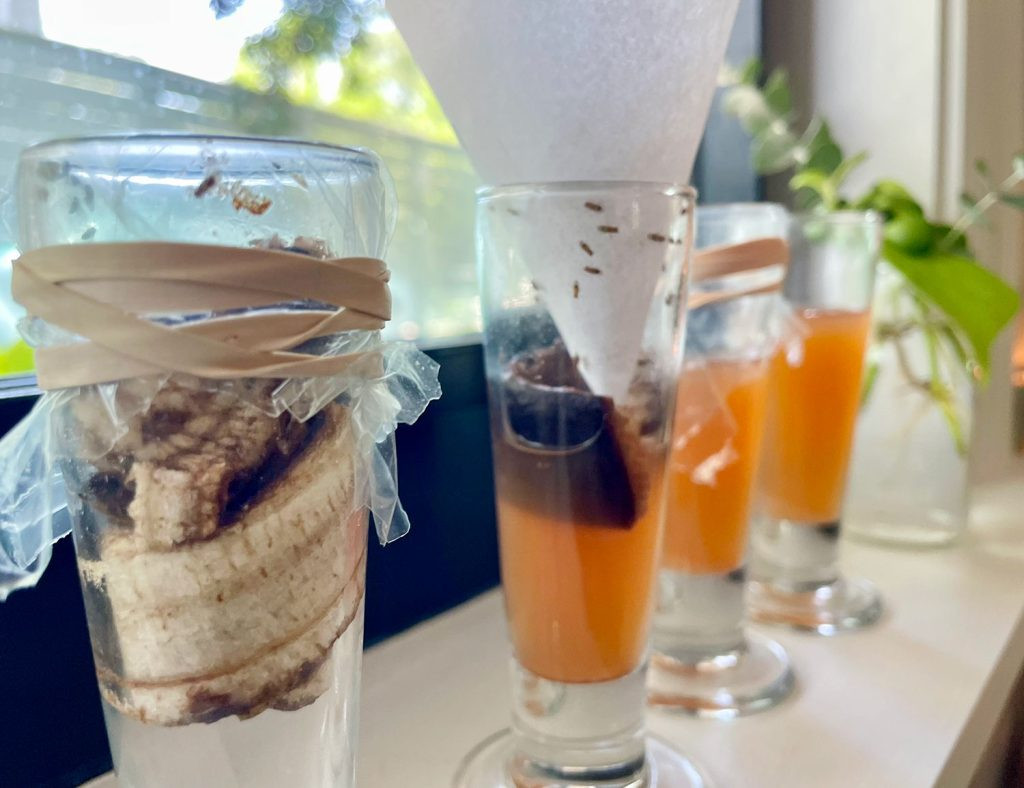 4 DIY Fruit Fly Traps Close Up
4 DIY Fruit Fly Traps Close Up
Our results indicated that the type of bait was more critical than the trap design itself. Traps using banana peel as bait performed significantly better than those using only apple cider vinegar. Although the Plastic Wrap Traps were very similar in design, the one baited with banana peel dramatically outperformed the one with ACV and dish soap. Perhaps apple cider vinegar becomes less appealing when real fruit is nearby?
Therefore, our recommendation is that regardless of the trap style you choose, include a piece of fruit scrap as bait! We slightly preferred the plastic wrap trap due to its ease of construction and stability. We accidentally knocked over the funnel trap once, releasing some flies back into the kitchen – oops!
What Bait Attracts Fruit Flies the Most?
This led to further experimentation to determine the most effective fruit bait. We tested three readily available fruits: banana peel, apple slices, and a strawberry. Each fruit was placed in a separate Plastic Wrap Trap and positioned side-by-side on our countertop for 24 hours.
While the banana peel initially seemed promising (being the most ripe at the start), the fruit flies were ultimately most attracted to the strawberry. The banana peel still captured a good number of flies, but as the strawberry ripened further, it attracted even more. Interestingly, the apple slices didn’t catch a single fruit fly!
Store-Bought Fruit Fly Traps: A Convenient Alternative
If DIY methods aren’t working for you, or if you prefer a ready-made solution, several effective store-bought fruit fly traps are available. These traps have overwhelmingly positive reviews and are generally priced under $20. They might be a good option if you want to catch other types of flying insects or prefer a more discreet trap design.
 Collage of Storebought Fruit Fly Traps
Collage of Storebought Fruit Fly Traps
During our testing, we purchased a pack of Terro Fruit Fly Traps to compare their performance against our homemade traps. We placed a Terro trap next to our banana and strawberry traps for 24 hours to see which performed best.
Again, our homemade strawberry trap was the most effective, closely followed by the banana peel trap. The store-bought trap only caught a single fruit fly in the initial 24-hour period. HOWEVER…
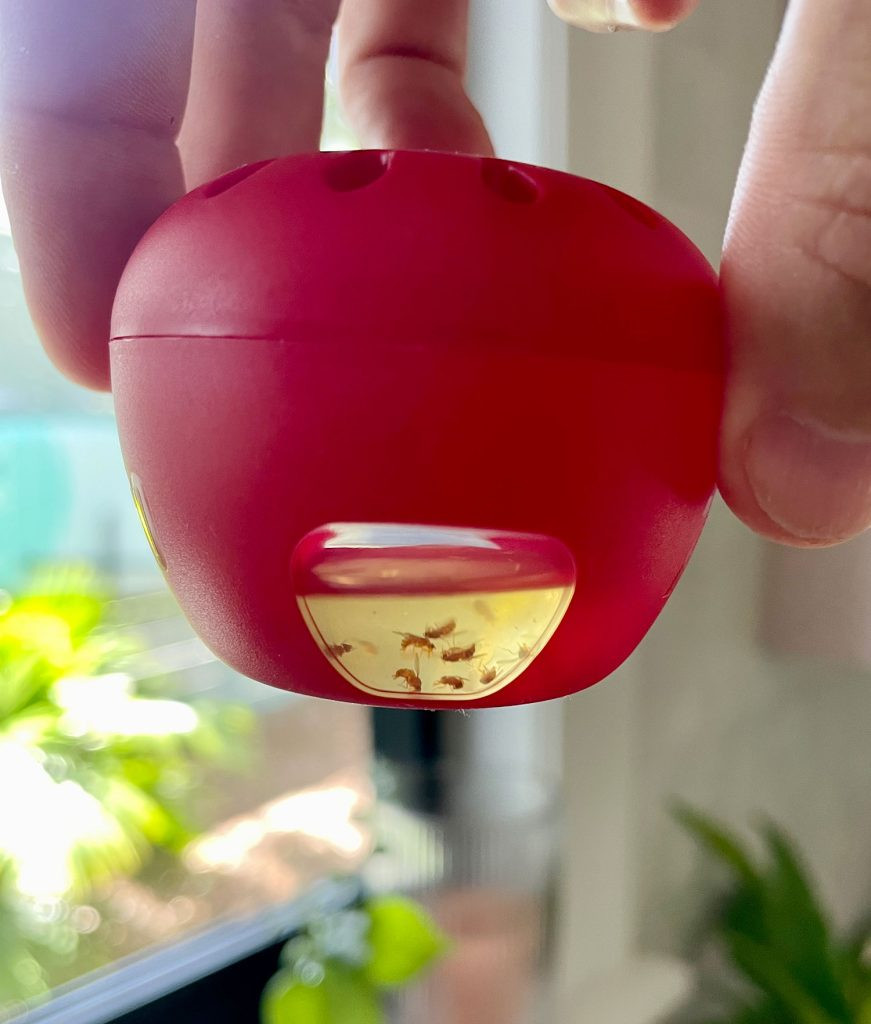 Terro Fruit Fly Trap With Dead Fruit Flies Visible
Terro Fruit Fly Trap With Dead Fruit Flies Visible
To ensure a fair comparison, we discarded our DIY traps and left the store-bought trap out for another 24 hours. Over this extended period, it captured a significant number of fruit flies, as pictured above. So, store-bought traps definitely work, just not as rapidly or effectively as our homemade traps in the initial burst. Our conclusion? Store-bought traps are suitable if you want a more visually appealing option, especially for long-term use. However, homemade traps are the best way to quickly and effectively eliminate fruit flies right away!
Preventing Fruit Flies: Stop Infestations Before They Start
While getting rid of fruit flies is relatively easy, preventing them from infesting your home in the first place is the ideal scenario. Here are some simple preventative measures you can take:
- Maintain Clean Kitchen Surfaces: Regularly wipe down kitchen counters, stovetops, tables, and all surfaces prone to collecting food residue or spilled liquids. Fruit flies are particularly attracted to fruit, sweet juices, and alcohol, so prevent these from lingering.
- Regularly Empty Trash Cans: Food scraps left in your garbage, especially overnight, can quickly become a breeding ground for fruit flies. Dispose of trash frequently.
- Promptly Dispose of Overripe Fruit: Monitor your fruit bowl and compost bin for overripe or rotting fruits like apples and bananas. Discard them before they attract fruit flies.
- Wash Produce Immediately After Purchase: Washing fruits and vegetables as soon as you bring them home from the grocery store can eliminate any fruit fly eggs or larvae that may be present (except for berries, which may spoil faster if washed immediately).
- Refrigerate Produce When Possible: Fruit flies do not thrive in cold environments. When feasible, store your fruits and vegetables in the refrigerator to deter them.
- Clean Sink Drains Regularly: Food particles accumulating in your sink drain can also attract fruit flies. Use your garbage disposal regularly and flush drains with hot water or a drain cleaner periodically.
Finally, remember not to panic if you spot fruit flies in your home. While prompt action is advisable to prevent the problem from worsening, the solutions outlined in this guide are straightforward, effective, and fast-acting. You might even find the process of becoming a fruit fly scientist, like I did, surprisingly engaging!
*This post contains affiliate links, so we may earn a small commission when you make a purchase through links on our site at no additional cost to you.